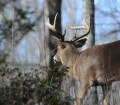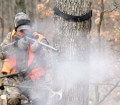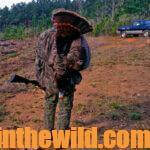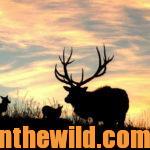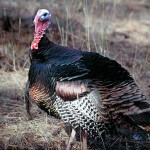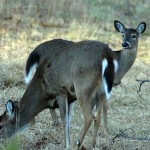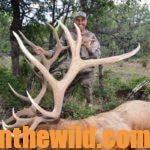John’s Note: Between the cover where they bed down, and the places where they feed, trophy-rack bucks are on the move and vulnerable, especially early in the morning and late in the afternoon. You can identify the places they prefer to be and take more deer.
During the mating season, sex is the #1 deer lure. Often a buck will forego food for a few days to service does during the rut. Unlike a man who buys a flashy automobile and expensive suits, has his hair styled and flashes big money to attract the feminine gender, a buck prepares a scrape. The scrape is usually made along an old logging road, a trail or some other path through the woods. Often a scrape can be found on the edges of fields too. Generally a scrape consists of a pawed area from 2 – 6 feet in diameter. In this pawed ground, the buck urinates to leave a strong scent for the doe. Then the buck will crunch but not eat the limbs and leaves of an overhanging bush or tree above the pawed ground to leave his scent from his mouth. He also will drag the brush past his eyes and nose again to leave his scent for passing does. Finally he will rub trees and bushes with his antlers to leave a visible sign for the doe.
 Most bucks make a series of scrapes – a scrape line. When a doe is ready or nearly ready to breed, the best scenario is that she finds one of these scrapes. She will wait in that region for the buck to come by and service her. Most of the time the buck will check his scrape at least once every 3 days. However, the times he chooses to check his scrape line may not be always during daylight hours. A hunter’s chances of taking a deer are extremely good, if he positions himself 20-30 yards away from a scrape during the rut.
Most bucks make a series of scrapes – a scrape line. When a doe is ready or nearly ready to breed, the best scenario is that she finds one of these scrapes. She will wait in that region for the buck to come by and service her. Most of the time the buck will check his scrape at least once every 3 days. However, the times he chooses to check his scrape line may not be always during daylight hours. A hunter’s chances of taking a deer are extremely good, if he positions himself 20-30 yards away from a scrape during the rut.
The two best places to watch for bucks are between two or more scrapes – so you can see the buck coming from either direction – or between a food source and a scrape. Just because the rut is on, the buck won’t starve himself to death. So, food sources still will lure in a male whitetail. The does he is searching for also will have to feed. The area or trail between the food and the scrape often makes a productive ambush point for the hunter.
 Water Holes:
Water Holes:
During droughts and in arid country, many deer often will concentrate around water holes or creeks. But remember – a large amount of the water required for body maintenance comes from the food the deer eat. So, watering holes may not be as preferred an area to hunt as other deer attractions. However, if fresh tracks and droppings are found, and a buck has been sighted at a water hole or along a creekbank, this region also may provide a preferred spot to meet a nice buck. But there are some cautions. Remember that as a buck approaches an area he frequents regularly, he is extremely conscious of danger. For this reason the hunter should take a stand 50-100 yards away from the watering area. He also should plan to bag his buck coming to or going away from the water, as the animal may not be as easy to spook before or after he arrives at the water.
 To get John E. Phillips’ Kindle eBooks and print books on hunting deer, “How to Hunt and Take Big Buck Deer on Small Properties,” “How to Hunt Deer Up Close: With Bows, Rifles, Muzzleloaders and Crossbows,” “PhD Whitetails: How to Hunt and Take the Smartest Deer on Any Property,” “How to Take Monster Bucks,” “How to Hunt Deer Like a Pro,” and “Bowhunting Deer: Mossy Oak Pros Know Bucks and Bows,” or to prepare venison, “Deer & Fixings,” click here.
To get John E. Phillips’ Kindle eBooks and print books on hunting deer, “How to Hunt and Take Big Buck Deer on Small Properties,” “How to Hunt Deer Up Close: With Bows, Rifles, Muzzleloaders and Crossbows,” “PhD Whitetails: How to Hunt and Take the Smartest Deer on Any Property,” “How to Take Monster Bucks,” “How to Hunt Deer Like a Pro,” and “Bowhunting Deer: Mossy Oak Pros Know Bucks and Bows,” or to prepare venison, “Deer & Fixings,” click here.
For information on making jerky from your deer to provide a protein-rich snack, you can download a free book from https://johninthewild.com/free-books.

